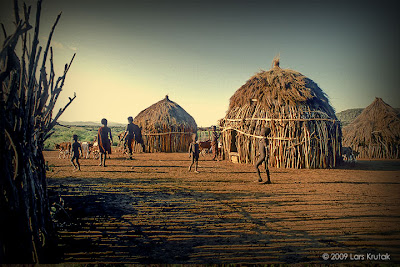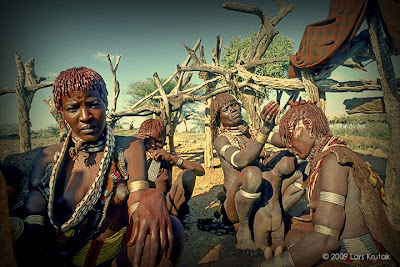Photos By: Lars Krutak.
Help taken from: BBC and Lars Krutak.
The Hamar are an Omotic community inhabiting southwestern Ethiopia. They live in Hamer woreda, a fertile part of the Omo River valley.
The Omo Valley has been described as Ethiopia’s “poisoned paradise” because although its landscape is at times extremely beautiful, especially after the rainy season when the verdant valley is filled with plant life, the rest of the year it sizzles in extreme heat much like the Arizona desert. Of course, you’re not going to find much electricity, running water, or even medical clinics here.
However, for many ethnic groups like the Hamar people and their sworn enemies the Bume and Galeb, this territory has been called home for hundreds of years. Largely undisturbed and little visited until the recent influx of tourism development, it is in this harsh environment that exotic tribes with animistic religions and ancient customs have remained relatively intact.
The Hamar live among the bush covered hills on the eastern side of the Omo Valley in southern Ethiopia. They are a tribe with unique rituals such as a cattle-leaping ceremony that men go through in order to reach adulthood, whereupon young Hamar women get whipped to prove their love for their kinsmen.
The 15,000 to 20,000 members of the Hamar make their living as successful cattle herders and farmers. Once they hunted, but the wild pigs and small antelope have almost disappeared from the lands in which they live; and until 20 years ago, all ploughing was done by hand with digging sticks.
Often families will pool their livestock and labour to herd their cattle together. In the dry season, whole families go to live in grazing camps with their herds, where they survive on milk and blood from the cattle. Just as for the other tribes in the valley, cattle and goats are at the heart of Hamar life. They provide the cornerstone of a household's livelihood; it’s only with cattle and goats to pay as ‘bride wealth’ that a man can marry.
There is a division of labour in terms of sex and age. The women and girls grow crops. They’re also responsible for collecting water, doing the cooking and looking after the children - who start helping the family by herding the goats from around the age of eight. The young men of the village work the crops, defend the herds or go off raiding for livestock from other tribes, while adult men herd the cattle, plough with oxen and raise beehives in acacia trees.
Sometimes, for a task like raising a new roof or getting the harvest in, a woman will invite her neighbours to join her in a work party in return for beer or a meal of goat, specially slaughtered to feed them. Hamar parents have a lot of control over their sons, who herd the cattle and goats for the family. It’s the parents who give permission for the men to marry, and many don’t get married until their mid-thirties. Girls, on the other hand, tend to marry at about 17.
Marriage requires ‘bride wealth’, a payment made to the woman’s family and generally made up of goats, cattle and guns. Although it’s paid over time like instalments of a bank loan, it’s so high (30 goats and 20 head of cattle) that it can't usually be paid back in a lifetime. If a man can afford the bride wealth, he can have three or four wives. Women only marry one man. Because men tend to be older than their wives, they often die first. Lots of Hamar households are headed by women who have survived their husbands.
Brothers and sisters are important to each other in other ways. The most dramatic example is the ritual whipping before a brother’s cattle-leaping ceremony.
A Hamar man comes of age by leaping over a line of cattle. It’s the ceremony which qualifies him to marry, own cattle and have children. The timing of the ceremony is up to the man’s parents and happens after harvest. As an invitation, the guests receive a strip of bark with a number of knots – one to cut off for each day that passes in the run up to the ceremony. They have several days of feasting and drinking sorghum beer in prospect.
On the afternoon of the leap, the man’s female relatives demand to be whipped as part of the ceremony. The girls go out to meet the Maza, the ones who will whip them – a group of men who have already leapt across the cattle, and live apart from the rest of the tribe, moving from ceremony to ceremony. The whipping appears to be consensual; the girls gather round and beg to be whipped on their backs. They don’t show the pain they must feel and they say they’re proud of the scars. They would look down on a woman who refuses to join in, but young girls are discouraged from getting whipped.
One effect of this ritual whipping is to create a strong debt between the young man and his sisters. If they face hard times in the future, he’ll remember them because of the pain they went through at his initiation. Her scars are a mark of how she suffered for her brother.
As for the young man leaping over the cattle, before the ceremony his head is partially shaved, he is rubbed with sand to wash away his sins, and smeared with dung to give him strength. Finally, strips of tree bark are strapped round his body in a cross, as a form of spiritual protection.
Meanwhile, the Maza and elders line up about 15 cows and castrated male cattle, which represent the women and children of the tribe. The cattle in turn are smeared with dung to make them slippery. To come of age, the man must leap across the line four times. If he falls it is a shame, but he can try again. If he is blind or lame he will be helped across the cattle by others. Only when he has been through this initiation rite can he marry the wife chosen for him by his parents, and start to build up his own herd. Once his marriage has been agreed upon he and his family are indebted to his wife's family for marriage payments amounting to 30 goats and 20 cattle.
It doesn’t stop there. Wife beating is an accepted part of life rather than a taboo, and the convention is that a man will not generally tell his wife why she is being whipped. On the other hand, if a beating is severe then family or neighbours will step in; and after a couple have had two or three children, beating stops.
Of course the Hamar have always been successful at adapting to new cultural situations, otherwise they would have disappeared from the rugged landscape of what is Ethiopia’s last frontier hundreds of years ago. But will the government’s decision to outlaw pala scarification signal the beginning of the end for a practice that is at the very source of Hamar identity? Time will only tell.







This comment has been removed by the author.
ReplyDelete